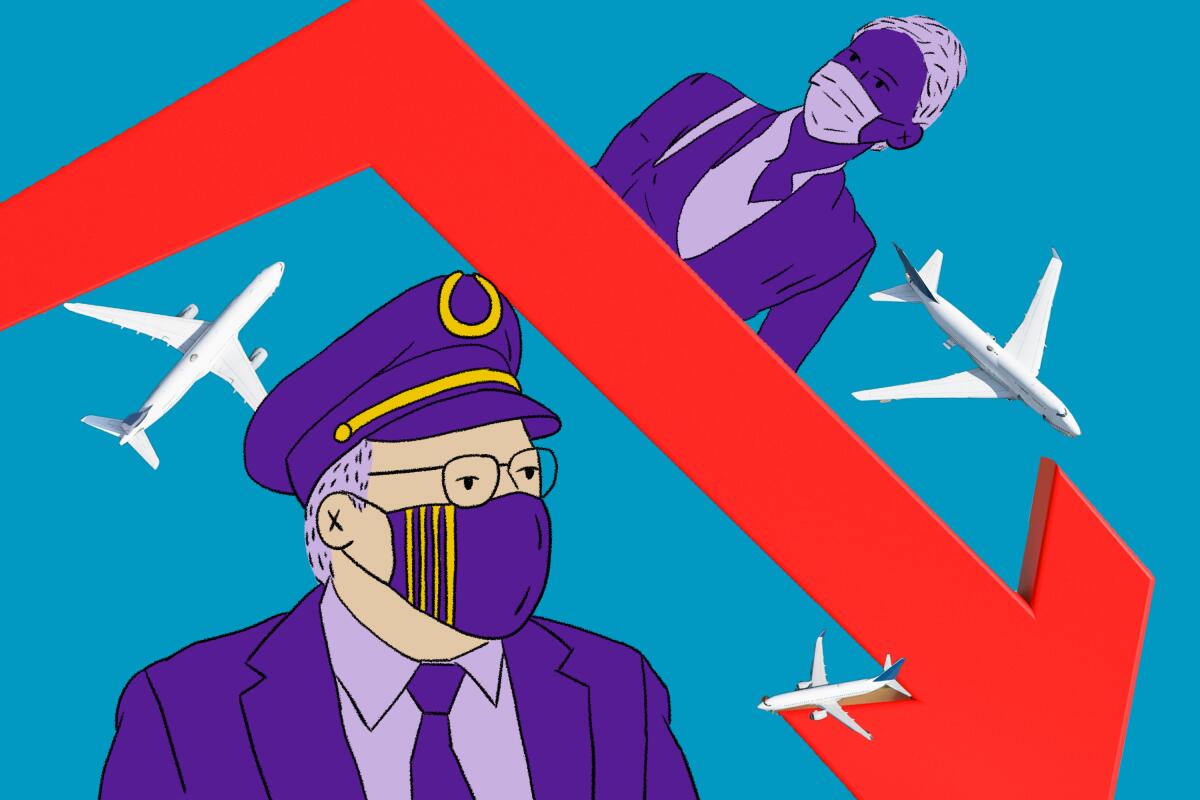I work for an airline. Soon 7,000 of my 27,000 colleagues may be out of a job

- Share via
The COVID-19 crisis has turned traveling by plane into a dystopian endeavor. Passengers and crew peer from behind face masks that help prevent transmission of the coronavirus. In an effort to curtail person-to-person contact, in-flight food and beverage service has been minimized or eliminated.
Casual conversations are a relic of the past, replaced by unspoken questions about a seatmate’s personal hygiene. Reduced travel demand has created fewer flight options and increasingly crowded airplanes.
For passengers, air travel is awkward and worrisome. For airline employees facing job cuts, the situation is much worse.
In an effort to remain solvent, the U.S. airline I work for (one of the world’s largest) made the inevitable decision to downsize. During our darkest days in April, capacity fell by 80%, pushing revenue to a negative position.
By June, revenue had crept up to $1 billion, compared with $4 billion in 2019. The 75% drop and bleak outlook for future profits forced the airline to slash flights, retire aircraft and cut costs.
Pilots, flight attendants, customer service agents, baggage handlers, management personnel, mechanics and others were asked to accept early-retirement packages, leaves of absence or reduced work schedules.
These concessions, however, will not keep the airline airborne.
The Coronavirus Aid, Relief, and Economic Security (CARES) Act provided the airline with $5.8 billion in payroll support from the U.S. Department of the Treasury. In exchange for the cash, the company agreed not to furlough employees until Sept. 30. As that date approaches, the airline faces a difficult decision.
Approximately 27,000 flight attendants are employed by the airline. According to a management letter posted on our employee website, by the end of September when the furlough restriction ends, some 7,000 to 8,000 flight attendants may become redundant.
In a last-ditch effort to reduce those numbers, the airline will offer a third and final early-retirement package. (Previous packages included a one-time payout of up to $32,000, two years of group healthcare insurance and free, space-available air travel.)
Additional leaves of absence will be offered to further reduce the ranks. Once these numbers are calculated, the airline will know precisely how many flight attendant jobs are at risk.
The letter went on to say two of 12 operational bases are closing. Flight attendants stationed in St. Louis and Raleigh, N.C., will be reassigned to bases in Dallas and Charlotte, N.C., respectively.
Displaced flight attendants are left with two unappealing options: Uproot their families and move to the new base or commute by plane to and from their base using space-available employee travel passes. (Those unwilling to move from Raleigh to Charlotte have the added option of a 2½-hour drive to the airport.)
For anyone facing a furlough, however, commuters and base transferees are in enviable positions.
In the letter to flight attendants, management explained there will be fewer crew members scheduled to work a flight. Beginning in October, staffing on wide-body aircraft is reduced to the Federal Aviation Administration minimum (10) plus one. For example, long-haul flights to Europe and South America on Boeing 777-300 are staffed with 13 flight attendants. Come October, that number drops to 11.
From a safety standpoint, nothing changes. One flight attendant, as per FAA regulations, is assigned to each of the aircraft’s 10 doors. But because in-flight service has been pared, 11 flight attendants will remain to serve 304 passengers on a typical eight- to 10-hour flight.
Perhaps the most harrowing announcement was that 19 of our international routes have been terminated. Not postponed. Terminated. We will no longer fly from Los Angeles to Shanghai, Beijing, Hong Kong, Buenos Aires or São Paulo, Brazil. Other hubs — Chicago, Miami, Philadelphia and Charlotte — have terminated routes to Milan, Italy; Barcelona, Spain; Paris; Berlin; and Budapest, Hungary.
These drastic cost-cutting measures create a trimmed-down airline better suited for survival. But for thousands of airline employees bracing for September, survival is a bitter pill to swallow.
More to Read
Sign up for The Wild
We’ll help you find the best places to hike, bike and run, as well as the perfect silent spots for meditation and yoga.
You may occasionally receive promotional content from the Los Angeles Times.






